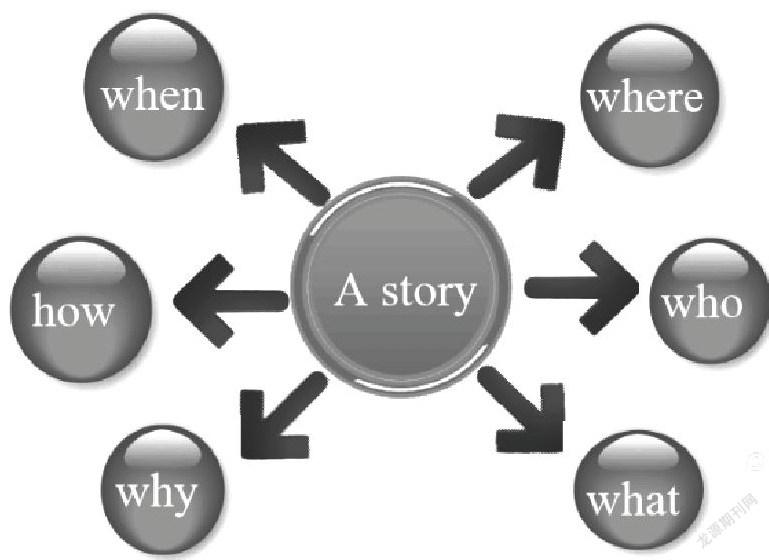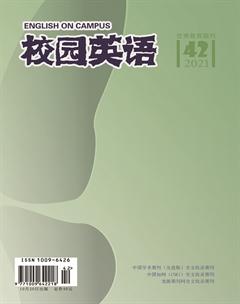基于读思言模型高中英语读后续写教学初探
2021-01-03黄志强

【摘要】黃远振教授英语读思言模型构念包括读(阅读、导读、默读、朗读)、思(思考、思索、探究、交流)、言(表达、说和写表达技能、说或写的思维产品)。而高中英语读后续写是新高考的考试作文题型,以记叙文故事类文章或者夹叙夹议类文章为主,故事线索的逻辑性比较强。以读促写有意识地培养学生的创造性思维能力;以例导写,让学生有例可循,提高写作能力。本文分析高中英语读后续写的要求,设计目的和评分标准,以一堂读后续写课为例,探究如何在高中英语教学中展开读后续写。提出教师应引导学生通读文本,分析人物性格,确定故事的主要脉络;结合续写段落给定句子的开头,确定故事走向;平衡文本中给定的画线词,确定故事情节;结合故事情节,升华主题。在此基础上,揭开高中英语读后续写的奥秘。
【关键词】读思言;高中英语;读后续写;以例导写
【作者简介】黄志强,福建省泉州市泉州第六中学。
黄远振教授的读思言理论依据是阅读学、思维学和语言学。本文主要解析如何利用“读思言”+教学路径,根据文本内容,聚焦“思”的设计:以“思”为着力点,提出个性化可操作方法。
首先,我们先来分析读后续写的考纲说明。提供一段350词以内的语言材料,原文多是情节丰富的记叙文或者是夹叙夹议类文章,要求考生依据该材料内容、所给段落开头语和所标示关键词进行续写(150词左右),将其发展成一篇与给定材料有逻辑衔接、情节和结构完整的短文。
其次,我们一起来探究高中写作新题型读后续写要考查学生什么能力。高中读后续写旨在以读为辅,以写为主,目标是学生的综合语言运用能力,主要体现在四个方面:1.把握短文关键信息和语言特点的能力;2.语言运用的准确性和丰富性;3.对语篇结构的把握能力;4.创造性思维能力。
最后,我们一起来了解高考对读后续写的评分标准。第五档作文(21-25):1.与所给短文融洽度高,与所提供各段落开头语衔接合理;2.内容丰富,应用了5个以上短文中标出的关键词语;3.所使用语法结构和词汇丰富、准确,可能有些许错误,但完全不影响意义表达;4.有效地使用了语句间的连接成分,使所续写短文结构紧凑。
那么,我们要怎么指导学生写出高分作文?显然要按照读后续写的评分标准,结合黄远振教授的读思言理念,在日常教学中着重训练学生的 Reading(记叙文阅读理解能力)、Thinking (由读到写的思维能力) 和 Writing(记叙文书面表达能力)。
接下来,笔者以自己的一节公开课为例,读思言问题导向的读后续写,阐述如何以例导写?并希望借此揭开高中英语读后续写的奥秘。
一、读透材料,以例导写
首先,大概用8分钟到10分钟的时间进行文本材料的阅读,读透了才能写得好。
Beauty in Your Eyes
The park bench was deserted as I sat down to read beneath the long branches of an old willow tree. I was deserted. Endless quarrels with my family had left me nowhere to go but this desolate(荒凉的)corner of the park. As I sat on the bench, things happened recently began to flash through. Days seemed months to me recently. No cozy home to stay. No happy memories with family. No considerate family members to talk to. Even the book I was reading was no fun. Not content with life, I had a good reason to frown, for the world was intended to drag me down.
And if that weren't enough to ruin my day, a young boy out of breath approached me, all tired from play. He stood right in front of me with his head leaning down and said with great excitement, “Look what I found!” In his hand was a flower. What a pitiful sight, its petals(花瓣) were all worn——not enough rain, or too little light. He must have picked the flower from somewhere shady and sunless, just like where I was staying these days. I couldn’t help being self-pitying. Wanting him to take his dead flower away and go off to play, I faked a small smile and then looked away. “Why couldn't everyone just leave me be!” I thought to myself, upset and depressed.
But instead of leaving, he sat next to my side and placed the flower to his nose and declared loudly with certainty, “It sure smells pretty and it must be beautiful, too. That's why I picked it; here, it's for you.” The weed before me was dying or dead, not bright of colors, orange, yellow or red. But I knew I must take it, or he might never leave. So I reached for the flower, and replied, “Just what I need.” Again, instead of placing the flower in my hand, he held it mid-air without reason or plan. Curiosity drove me to look into his eyes. Blue as the sea, there is no color of light in his beautiful eyes.
续写要求:1.所续写短文的词数应为150左右;2.至少使用5个短文中有下划线的关键词语;3.续写部分分为两段,每段的开头语已为你写好;4.续写完成后,请用下划线标出你所使用的关键词语。
Paragraph 1
It was then that I noticed for the very first time that the boy could not see: he was blind.
Paragraph 2
For all of those times I myself had been blind towards the world around me.
首先,以读思言的思维导图的形式画出记续文六要素。
接着,分析本文的故事情节。
The plot(情节)of the story
Who :The author; a blind boy
when :One day after quarrels with my family
Where:In a park ;on a deserted bench
What: I sat down on a bench to read
A boy gave me a dead flower
Why: He thought this flower was beautiful .
How: ?
Main idea: As I sat down on a deserted bench to read, a boy approached me and gave me a dead flower,which he thought was beautiful.
二、分析续写的两段首句,进行情节设定。在情节设定时,要逻辑合理,有多种选择时,择优而选,传播正能量
第一段段首句分析与情节设定。
第一段首句:正是在那时我第一次意识到这个小男孩儿是盲人。
那么,当作者突然意識到小男孩儿是盲人的时候,她的情感发生什么变化?我们可以通过自己提出如下四个问题推动故事情节的发展。
Q1: How would I feel after knowing that the boy couldn't see?
Q2: What would I do with the boy's flower?
Q3: What would the boy do or say afterwards?
Q4: How would I feel about it?
第二段段首句分析与情节设定。
第二段首句:这些年来,我一直对我周围的世界视而不见(“瞎”)。
同理,我们也还是走情感路线,自己提出如下三个问题:
Q1: Why would I say I was blind?
Q2: What would I learn from the little boy?
Q3: How would I feel about my life later?
三、透过文本材料的故事情节,续写的结尾要进行主题升华
作者和家人在家里无休止地争吵,心情压抑,一个人独自到公园里散心。但是内心的沮丧使她觉得周围的环境也是一片荒芜,内心的凄凉也使她无心读书。甚至当盲人男孩儿拿着一朵花赠送给她的时候,她都觉得男孩子是在故意打扰自己。但是当作者发现男孩子是盲人的时候,花虽早已枯萎,但是男孩依然觉得很美。作者的内心起了巨大的波澜。她终于意识到一切都是她自己的问题。真正“瞎”的是她的内心,导致自己忽略了生活中的美。在续写部分,旨在通过学生的续写内容升华文本,弘扬积极乐观向上的生活态度,从而落实立德树人根本任务,促进学生的德智体美劳全面发展。
四、范文参考
Paragraph 1:
It was then that I noticed for the very first time that the boy could not see: he was blind. I heard my voice trembling. Tears shone like the sun as I thanked him for picking the very best flower. “You're welcome”, he smiled, and then ran off to play, not realizing the impact he'd had on my day. I sat there and wondered how he managed to see a self-pitying woman beneath an old willow tree. How he know of my self-indulged plight(困境)?Perhaps he'd been blessed with true sight from his heart by God.
Paragraph 2:
For all of those times I myself had been blind towards the world around me. Through the eyes of a blind boy, at last I could see, the problem was not with the world; the problem was me. I decided and promised to see beauty and appreciate every second of my life. Then I held that dead flower up to my nose and breathed in the fragrance of a beautiful rose, smiling like that young boy. Another flower in his hand was about to change the life of an unsuspecting old woman.
综上所述,“读思言”的教学模式确实能够在一定程度上提高学生的阅读、思维和表达能力。“读思言”+教学路径,让学生在实践的过程中,能够围绕文本的要点来设计有效的问题,能够更好地推动学生进行积极思考。学生在读后续写中,不但要有把握文章主题,理清文章脉络的能力,还要良好的创造性想象思维能力,能构思故事情节,写出符合逻辑的故事结尾,续写文章时能择优而选,传播正能量,也因此能够将其发展成一篇与给定材料有逻辑衔接、情节和结构完整的短文。
参考文献:
[1]黄远振,黄睿.英语深读教学读思言模型构念与实践研究[J].福建基础教育研究,2019(4):62-67.
[2]王慧涓.浅谈读后续写提升学生阅读及写作能力[J].高考,2019 (5):127-128.
[3]胡洁元.读后续写的协同效应研究及应对策略[J].中小学外语教学(中学篇),2016(11):1-5.
[4]姜琳,陈锦.读后续写对英语写作语言准确性、复杂性和流利性发展的影响[J].现代外语,2015(3):366-375,438.
[5]王敏,王初明.读后续写的协同效应[J].现代外语,2014(4):501-502.
